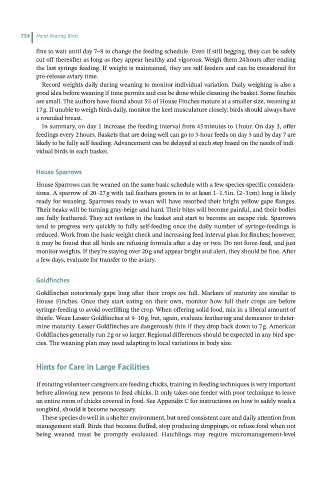Page 752 - Hand rearing birds second
P. 752
754 Hand-Rearing Birds
fine to wait until day 7–8 to change the feeding schedule. Even if still begging, they can be safely
cut off thereafter as long as they appear healthy and vigorous. Weigh them 24 hours after ending
the last syringe feeding. If weight is maintained, they are self‐feeders and can be considered for
pre‐release aviary time.
Record weights daily during weaning to monitor individual variation. Daily weighing is also a
good idea before weaning if time permits and can be done while cleaning the basket. Some finches
are small. The authors have found about 5% of House Finches mature at a smaller size, weaning at
17 g. If unable to weigh birds daily, monitor the keel musculature closely; birds should always have
a rounded breast.
In summary, on day 1 increase the feeding interval from 45 minutes to 1 hour. On day 3, offer
feedings every 2 hours. Baskets that are doing well can go to 3‐hour feeds on day 5 and by day 7 are
likely to be fully self‐feeding. Advancement can be delayed at each step based on the needs of indi-
vidual birds in each basket.
House Sparrows
House Sparrows can be weaned on the same basic schedule with a few species‐specific considera-
tions. A sparrow of 20–27 g with tail feathers grown in to at least 1–1.5 in. (2–3 cm) long is likely
ready for weaning. Sparrows ready to wean will have resorbed their bright yellow gape flanges.
Their beaks will be turning gray‐beige and hard. Their bites will become painful, and their bodies
are fully feathered. They act restless in the basket and start to become an escape risk. Sparrows
tend to progress very quickly to fully self‐feeding once the daily number of syringe‐feedings is
reduced. Work from the basic weight check and increasing feed interval plan for finches; however,
it may be found that all birds are refusing formula after a day or two. Do not force‐feed, and just
monitor weights. If they’re staying over 20 g and appear bright and alert, they should be fine. After
a few days, evaluate for transfer to the aviary.
Goldfinches
Goldfinches notoriously gape long after their crops are full. Markers of maturity are similar to
House Finches. Once they start eating on their own, monitor how full their crops are before
syringe‐feeding to avoid overfilling the crop. When offering solid food, mix in a liberal amount of
thistle. Wean Lesser Goldfinches at 9–10 g, but, again, evaluate feathering and demeanor to deter-
mine maturity. Lesser Goldfinches are dangerously thin if they drop back down to 7 g. American
Goldfinches generally run 2 g or so larger. Regional differences should be expected in any bird spe-
cies. The weaning plan may need adapting to local variations in body size.
Hints for Care in Large Facilities
If rotating volunteer caregivers are feeding chicks, training in feeding techniques is very important
before allowing new persons to feed chicks. It only takes one feeder with poor technique to leave
an entire room of chicks covered in food. See Appendix C for instructions on how to safely wash a
songbird, should it become necessary.
These species do well in a shelter environment, but need consistent care and daily attention from
management staff. Birds that become fluffed, stop producing droppings, or refuse food when not
being weaned must be promptly evaluated. Hatchlings may require micromanagement‐level

